Homeowners Insurance
Nearly 3 in 4 Americans Prep for Winter, but It Comes at an Expensive Cost
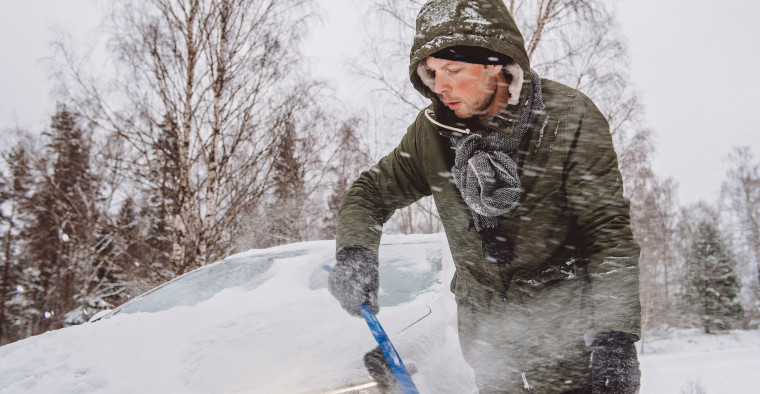
Those long summer days are a distant memory, and the winter gloom is fast approaching. While some may love cozying up indoors, most admit it’s an expensive season — and not just because of the holidays.
According to the latest ValuePenguin survey of 2,000 U.S. consumers, Americans spend an average of $1,258 prepping their cars and homes (and more) for winter.
Here’s what else we found.
On this page
- Key findings
- Nearly three-fourths of Americans will make winter preparations
- Power outages are a top concern — here’s what Americans are doing to prepare
- 29% are worried they won’t be able to afford winter damage repairs
- Only half of those who’ve experienced winter weather damage filed a claim
- Preparing for winter: Top expert tips
- Methodology
Key findings
- Winter is coming — and preparation can be costly depending on where you live. 74% of Americans will make winter preparations this year for their car and/or home. Across all Americans, the annual cost of prepping for winter averages $1,258. Unsurprisingly, two-thirds (66%) of Americans say winter is the most expensive season to prepare for, with those in the Midwest and Northeast leading, at 78% for both. Even though winter can be costly, 32% of Americans say they love a good snow day and 18% of Westerners and Southerners wish they got snow.
- As winter approaches, staying safe and warm is top of mind for Americans. Power outages (46%), vehicle safety (40%) and frozen pipes (40%) are the top winter weather concerns — and many are doing what they can to mitigate those concerns. Among those winterizing their cars, 79% will do general maintenance and 57% will ensure their heater and defroster work properly. Among those preparing their homes for freezing temperatures, 58% will check or repair their heating systems, 47% will winterize their outdoor faucets and 46% will keep snow-clearing equipment handy.
- While Americans prioritize their physical safety, they aren’t doing enough to protect themselves financially. Although 29% say they’re worried they won’t be able to afford the cost of repairs from potential winter weather damage, 91% of those making home preparations haven’t included a review of their insurance policy. Reviewing your policy is critical to know what kind of coverage you have against winter perils — and whether you need to buy more coverage, especially if you live in an area where winter storms are becoming more common.
- Many have experienced winter storm damage in the past. Among the 32% of Americans who say their car and/or home has been damaged by winter storms, just half (50%) say they filed an insurance claim. However, almost all of those who filed a claim were covered at least partially (97%). Northeasterners are the most likely to experience damage (37%) and to file a claim (60%).
Nearly three-fourths of Americans will make winter preparations
As Americans look ahead to winter, 74% will make preparations this year for their car and/or home. Breaking that down further, 42% will prepare both their homes and cars for the cold season, while just over a quarter (26%) will only prepare their homes and 6% will only prepare their vehicles.
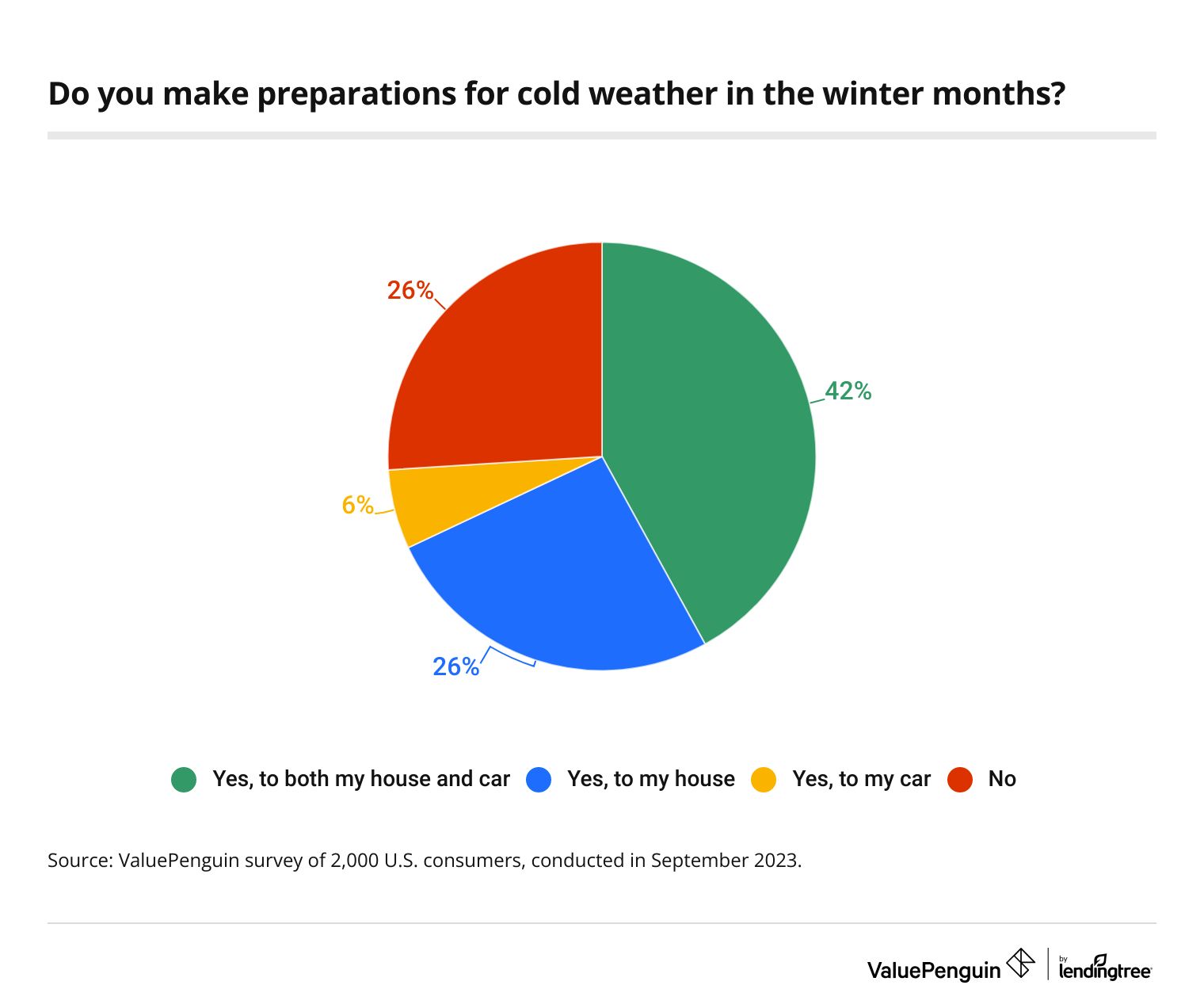
Of course, what winter means varies by region, and Americans prepare differently. Northeasterners and Midwesterners are the most likely to prepare, with 85% in both regions prepping their homes and/or cars. Meanwhile, Westerners are the least likely to do so, at 64%.
By generation, younger Americans are more likely to prep for the cold season than older Americans. Gen Zers ages 18 to 26 and millennials ages 27 to 42 are the most likely to do so, at 79% for both. That’s followed by:
- 71% of Gen Xers ages 43 to 58
- 68% of baby boomers ages 59 to 77
How much do Americans spend on winter? Across all respondents, Americans spend an average of $1,258 prepping for the cold season. By age group, millennials spend the most, at an average of $2,452 — nearly twice as much as Gen Zers ($1,232). Still, though, Gen Zers spend an average of seven times more than their baby boomer counterparts ($175).
Also worth noting, men ($1,804) spend significantly more to prepare for winter than women ($777). With little ones to look out for, those with children younger than 18 ($2,872) drastically outspend those without children ($566) and those with adult children ($164).
According to ValuePenguin insurance expert Divya Sangameshwar, the nature of the season plays a role in high spending.
"Winter — unlike a stand-alone extreme weather event — is a prolonged and destructive season," she says. "Americans know they’ll face significant threats to their physical and financial safety if they aren’t taking steps to protect themselves and their families against the cold — and this holds true among Americans who live in parts of the country where winters can be very brutal."
With that in mind, it’s understandable that two-thirds (66%) of Americans say winter is the most expensive season to prepare for. Those in the Midwest and Northeast are the most likely to say winter is the most expensive season, at 78% for both.
Dreaming of a white Christmas? You’re not alone. Despite high winter costs, 32% of Americans say they love a good snow day. And while 18% of Westerners and Southerners wish they got snow, 33% of Northeasteners and 31% of Midwesterners say their initial enjoyment of snow fades as the season goes on.
Power outages are a top concern — here’s what Americans are doing to prepare
Although there are several causes of concern for the winter season, power outages (46%) top the list. Following that, Americans are concerned about vehicle safety (40%) and frozen pipes (40%).
According to Sangameshwar, Americans are right to have these concerns.
"The extreme cold, freezing rain, snow, ice and high winds associated with the winter season lead to more car accidents, especially if cars aren’t appropriately prepared for the cold season," she says. "Power outages and frozen or burst pipes in a home can lead to hypothermia, frostbite, carbon monoxide poisoning from improperly started fires and even heart attacks from stress and overexertion. That’s why it’s good that Americans worry about these problems — even if they aren’t necessarily taking the right steps toward mitigating these problems."
What are Americans doing to prepare? Among those winterizing their cars, 79% will do general maintenance (like checking lights, batteries, fluids and oil) and 57% will ensure their heater and defroster are working properly. Following that:
- 46% will keep a survival kit in their car
- 41% will get their car thoroughly cleaned before and during the winter season to prevent corrosion and damage from road salt
- 36% will install winter wiper blades
- 25% will install snow tires
- 4% will take other precautions
While just a quarter (25%) will install snow tires, Westerners (39%) and Northeasterners (32%) are more likely to take this step than Midwesterners (23%) and Southerners (18%).
Meanwhile, among those preparing their homes, 58% will check or repair their heating systems — the top response. Nearly half (47%) will winterize their outdoor faucets, 46% will keep snow-clearing equipment handy and 43% will check and repair window seals.
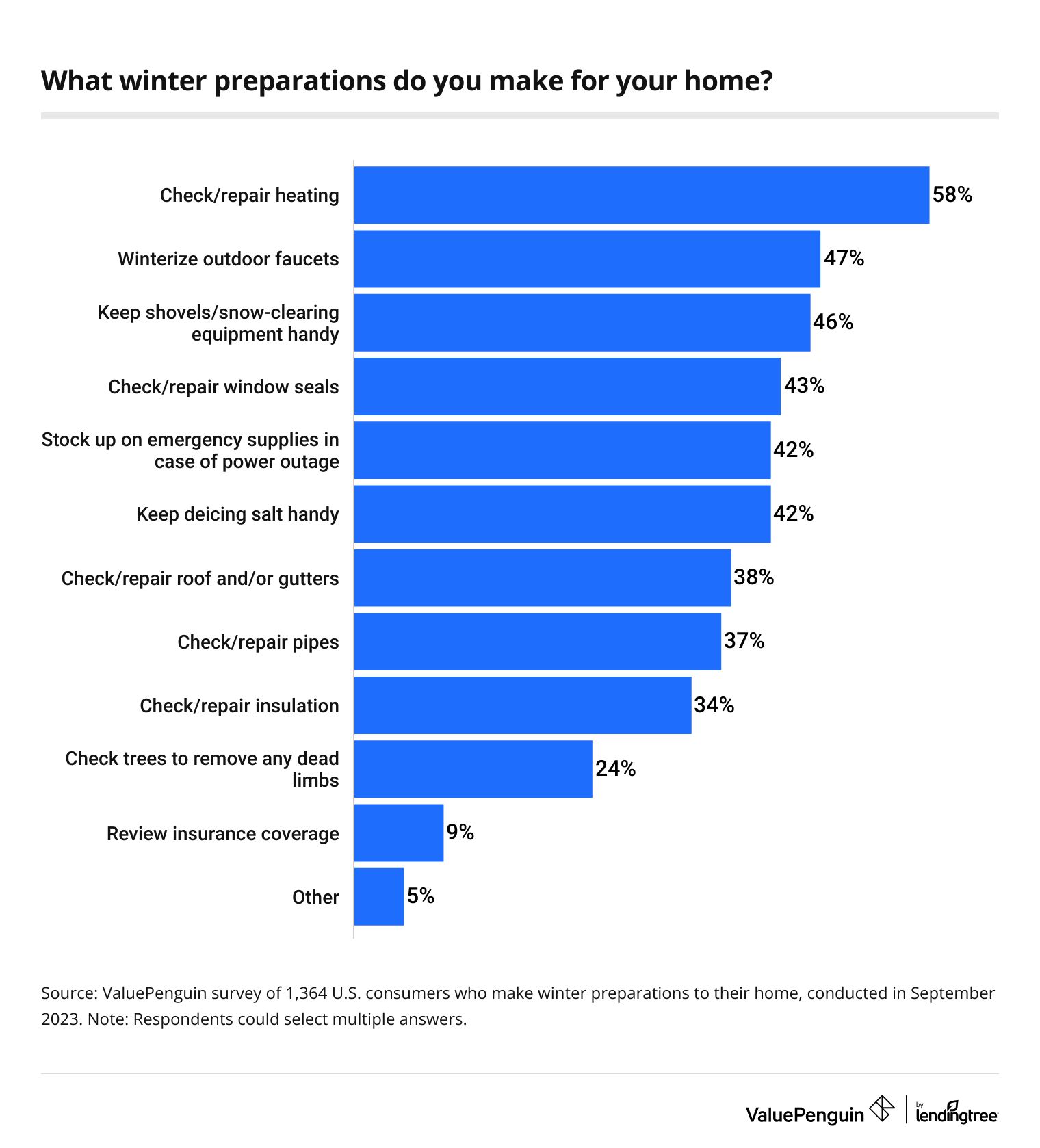
Sangameshwar says some of the most critical steps are being overlooked. "While most Americans are employing basic measures, they’re missing out on equally important measures," she says. "Things like removing dead branches from their trees and checking and fixing their insulation, pipes, roof and gutters are all vital for winter preparations."
When it comes to winter supplies Americans have on hand, blankets (56%), shovels (53%) and ice scrapers (53%) top the list. Alarmingly, though, 8% don’t have any winter supplies yet, with Southerners (11%) and Westerners (10%) the most likely to say so.
29% are worried they won’t be able to afford winter damage repairs
Preparing your home and car(s) isn't the only thing you should do. Americans commonly overlook their insurance, though many have cost-related concerns. Although 29% are worried they won’t be able to afford the cost of repairs from potential winter weather damage, just 9% have reviewed their insurance coverage.
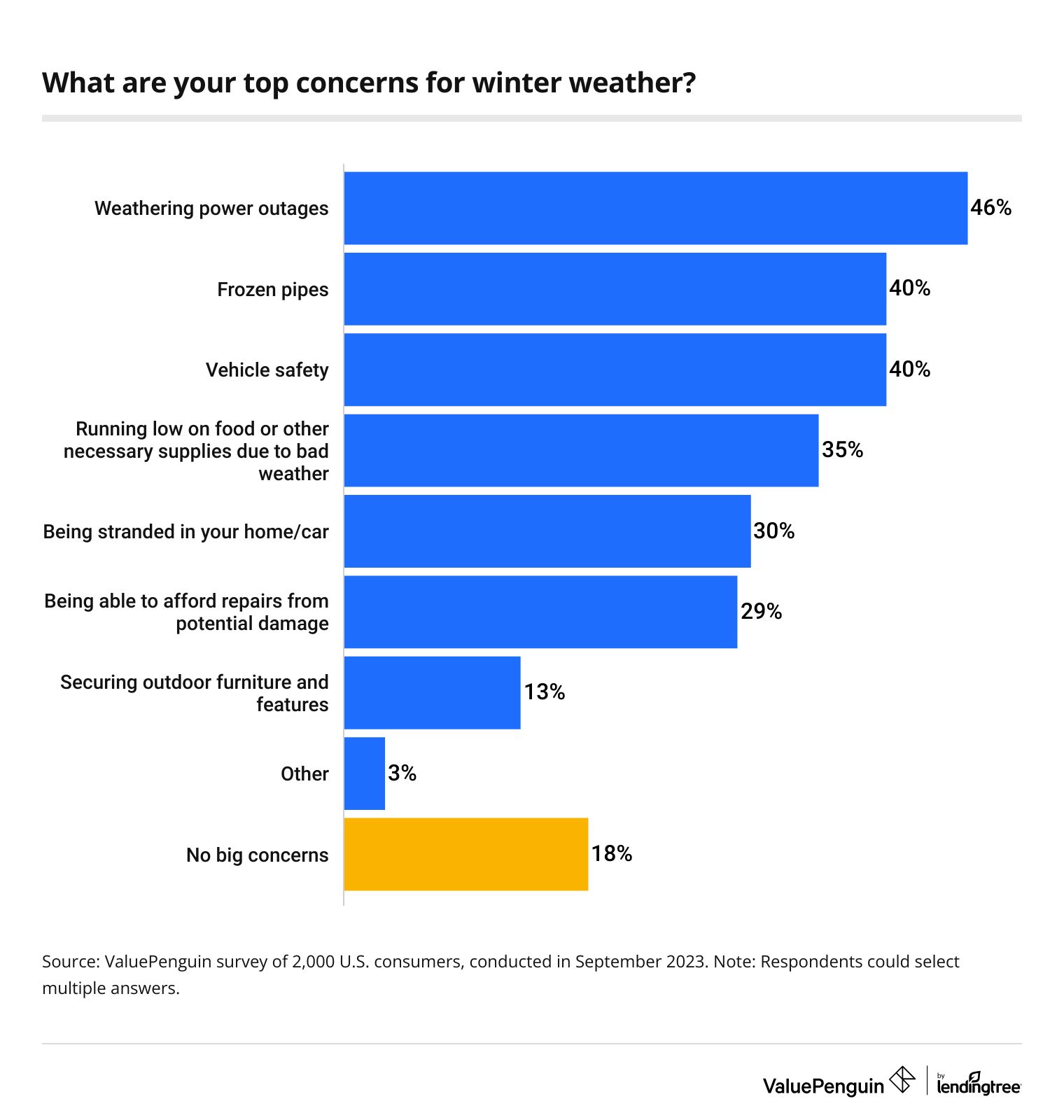
While most winter storm perils are covered under your home and car insurance policies, that’s not always the case. For example, if you live in an area that receives a lot of snow, your property may be at risk of flood damage as the weather warms in spring — a peril that requires separate flood insurance.
It’s also worth noting that winter weather caused $64.1 million in property damage in the U.S. in 2022 through July, according to a ValuePenguin study on winter weather damage — which highlights the importance of updating your policy, Sangameshwar says. "While it’s impossible to anticipate and prevent all types of damage, taking steps like checking and updating your insurance can give you the peace of mind that comes with knowing you’ve done everything you can to protect yourself financially," she says.
Changing weather patterns mean some Americans may be unprepared
As climate change continues to disrupt the weather, Americans' reliance on traditional weather patterns also puts them at risk.
This winter, El Nino (a warm jet stream that travels across the Pacific Ocean) is expected to bring a warmer and drier winter to the West and Midwest and a wetter and cooler winter to the South. While 85% of Midwesterners will prepare their homes and/or cars for the brutal winters they’ve come to expect, 30% of Southerners plan to make no winter preparations despite current predictions.
This also comes as 31% of Southerners have reported damage to their cars and/or homes from winter weather — more on that below.
Only half of those who’ve experienced winter weather damage filed a claim
Americans are no strangers to winter weather damage. In fact, 32% of Americans say their car and/or home has been damaged by winter storms, with Northeasterners (37%) and Midwesterners (33%) the most likely to say so by region.
Despite this, just half (50%) of those who’ve experienced damage have filed an insurance claim, again led by Northeasterners (60%). Among those who filed a claim, 70% say their insurance fully covered their claim and 27% say their insurance partially covered it.
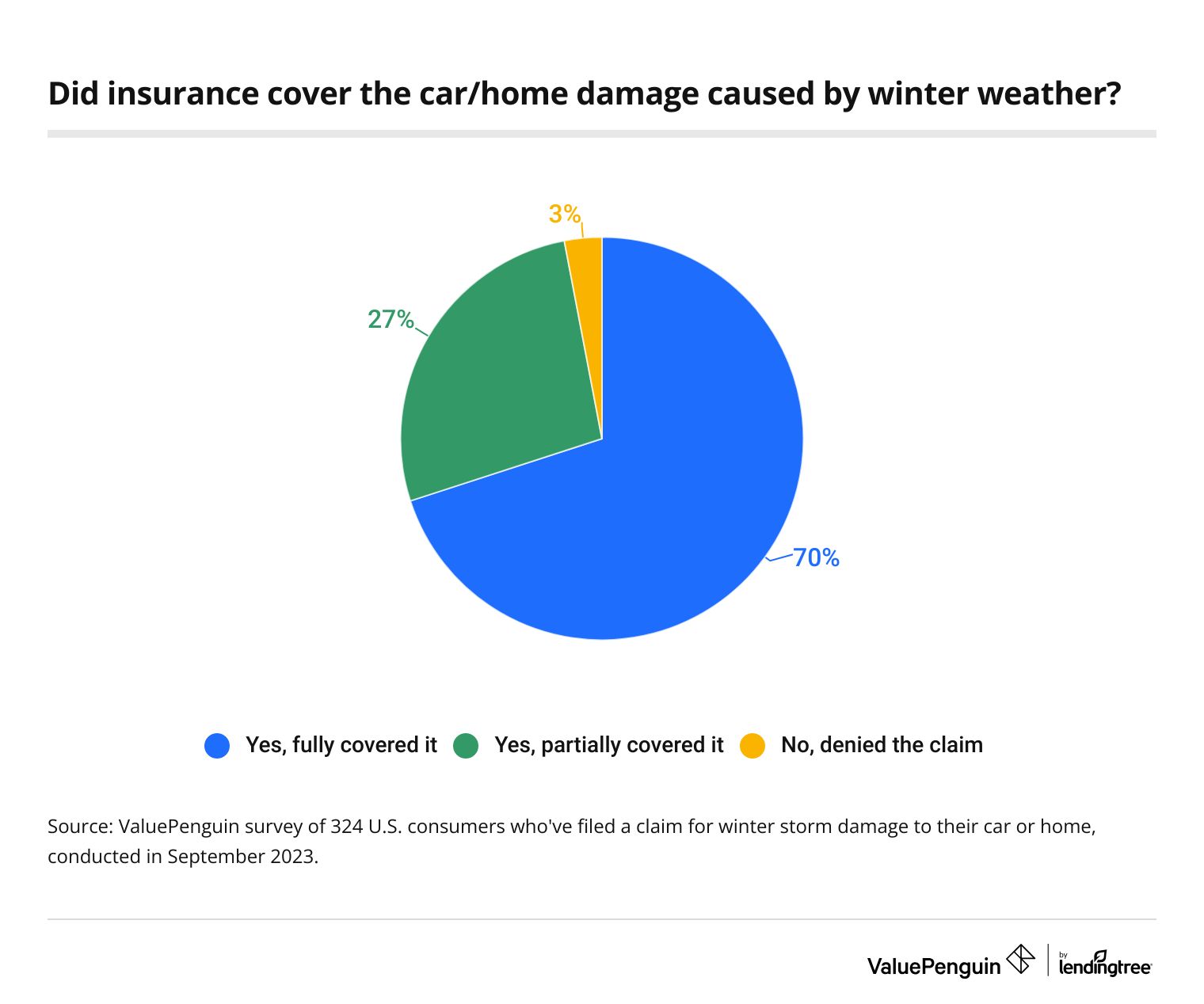
Although 31% of Southerners report experiencing winter weather damage, the 51% who filed a claim were slightly less likely to have it covered. Of the Southerners who filed an insurance claim for winter damage, 67% say their insurance fully covered their claim and 28% say their insurance partially covered it.
Preparing for winter: Top expert tips
Generally speaking, it’s important to know which winter perils your home and cars are at risk for — and what you can and should do to mitigate those risks. However, Sangameshwar says it’s equally important to know what your insurance will cover if the unexpected happens.
As you review your home and auto coverage, here are a few pointers to keep in mind:
- Ensure your home is fully protected. Under most standard homeowners insurance policies, repairs from most winter damage will be covered. "However, standard homeowners insurance policies may not cover damage from hail or high winds — especially if you live where wind and hail damage is common," Sangameshwar says. "Flood is also another winter peril becoming increasingly common that isn’t covered by a standard homeowners insurance policy."
- Protect yourself from out-of-pocket liability. "If your car slides on ice and hits another vehicle or a guest to your home slips and falls, liability insurance should spare you from out-of-pocket costs for any resulting lawsuits or damages," she says. "However, liability coverage has limits, and it’s important to review how much you have and increase it if your net worth exceeds your coverage by a large margin."
- Protect yourself and your vehicle in case of an accident. "While basic liability insurance may cover you, having collision insurance will be very helpful if you get into a crash with an uninsured driver," she says. "And to protect your vehicle in the event of noncollision damage — such as from a fallen tree or downed power line — you’ll need a comprehensive insurance policy. Additionally, if you or your passengers are injured during an accident in your vehicle, medical payments coverage will help pay for any hospital bills."
Methodology
ValuePenguin commissioned QuestionPro to conduct an online survey of 2,000 U.S. consumers ages 18 to 77 from Sept. 14 to 18, 2023. The survey was administered using a nonprobability-based sample, and quotas were used to ensure the sample base represented the overall population. Researchers reviewed all responses for quality control.
We defined generations as the following ages in 2023:
- Generation Z: 18 to 26
- Millennial: 27 to 42
- Generation X: 43 to 58
- Baby boomer: 59 to 77
